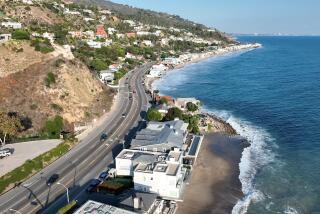Traffic Crashes Bring Physics to Life for High School Students
- Share via
ANCHORAGE — A Porsche makes a sudden left turn in front of a man on a motorcycle, who tries to stop using only his rear brake so he can maintain steering. The motorcycle lays down an 86-foot skid but T-bones the oncoming car on the passenger side.
Upon impact, the rider flies 84 feet through the air. The motorcycle flips onto the car roof.
How fast was the motorcycle traveling?
It’s not your typical high school physics problem. But beginning in the fall, students in Fairbanks high schools will have the chance to figure it out.
State troopers in Alaska have donated six traffic science kits based on actual cases that can be used in physics, biology and math classes. The kits contain interactive learning activities that show how police use physics to unravel traffic-collision mysteries.
Troopers hope that teenagers studying vectors, friction and projectile motion will apply the lessons to a matter they’re more concerned about: highway safety.
“We’re banking on teens’ fascination with speed and driving,” said trooper Lt. Lee Farmer of Fairbanks.
Classes Address Those Drivers Most at Risk
More than 6,000 Americans aged 16 to 20 die every year in traffic accidents, said Mary Moran of the state Highway Safety Office. “This age group also consistently engages in risk-taking behavior,” she said.
In 1999, drivers aged 16 to 20 crashed 3,833 times in Alaska, nearly 1,000 more times than the next closest age group, those 21 to 25. Among the younger drivers, nearly 75% were male. The crashes included eight fatalities, also higher than any age group.
“They tend to be overrepresented in crashes because they simply don’t have the experience,” Moran said.
Fairbanks science students will explore the aftermath of wrecks with course work titled “Crash: The Science of Collisions,” which was showcased in May at the 10th International Conference on Safe Communities in Anchorage.
The kits were developed by John Kwasnoski, a professor emeritus at Western New England College and a court-certified accident reconstructionist. Among other cases, he worked with police in re-creating the events of the Susan Smith double murder case in Union, S.C., in which she confessed to drowning her two young sons by rolling her car down a boat ramp in 1994.
In the lessons, students are presented with traffic scenes--just as professional investigators are--and are asked to tell what happened. All are actual cases that have been adjudicated.
“The kids love it because it’s a mystery,” Kwasnoski said. “Teachers like it because they’re covering the topic anyway. They buy in because it’s not intrusive. It’s assimilated right in the curriculum.”
Kwasnoski got the idea for the kits as he was training district attorneys in ways to use expert witnesses when prosecuting traffic cases.
“Part of the course was the physics of car crashes,” Kwasnoski said. Prosecutors who took physics in high school told him the concepts were making sense for the first time when applied to accidents.
With a grant from the National Highway Traffic Safety Administration, Kwasnoski put together kits that contain measuring devices, police photos and files, and manuals to show teachers how to apply traffic science. Some lessons can be used by sixth-graders. Some, such as the motorcycle accident, are for advanced physics students.
Farmer and other troopers saw a presentation on the curriculum. They concluded that the physics lessons were another way of looking at driving that may reach teenagers who suffer from “I Am Immortal Syndrome,” Farmer said.
Troopers around the state asked school administrators if they were interested in the kits.
“The only one that responded with any interest was the Fairbanks North Star Borough,” Farmer said.
Autopsy Report Most Popular Part of Kit
The kits cost $800 apiece. Troopers paid for 10%, and a federal grant administered through the state Highway Safety Office paid the rest.
“Anything we can do to help young people to learn more about the behaviors of driving, we’re all for it,” Moran said.
If Fairbanks teachers find the kits useful, troopers will push to place them in other communities.
The most popular exercise in the kit is the autopsy report in which students read the report, map the injuries on a drawing and decide whether the deceased was a passenger or the driver.
Kwasnoski said teaching Newton’s laws in the context of what happens to a driver who doesn’t wear a seat belt, or diagraming a severed aorta, makes a far greater impression than telling teenagers they could be hurt if they don’t buckle up.
“The safety message is a lot longer lived than preaching,” Kwasnoski said. “That’s a whole different level of understanding of what ‘killed’ means. It has just a tremendous realism that words don’t have.”
Crash: The Science of Collisions: www.legalsciences.com/crash.htm
More to Read
Sign up for Essential California
The most important California stories and recommendations in your inbox every morning.
You may occasionally receive promotional content from the Los Angeles Times.













